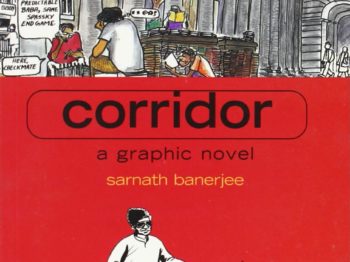
Sarnath Banerjee
2019-22 CAST Visiting Artist
Demystifying social science through creative storytelling
About the Residency
Ford Foundation International Professor of Economics Abhijit Banerjee hosts Visiting Artist Sarnath Banerjee (no relation) to create a novel medium that bridges the gap between the social science discourse of academia and the loud, inchoate, but intuitive expressions of everyday life. They share a conviction that story-telling is essential to social science as a method to reexamine the key ideas—such as poverty and efficiency—used to justify policies that can have disastrous and far-reaching effects.
Growth, greed, power, and short-termism are prominent themes in Professor Banerjee’s book Poor Economics (2011) as well as Sarnath Banerjee’s graphic novel All Quiet in Vikaspuri (2015). The project emerged from the shared research interests and years of conversations between the economist and artist that traversed global issues and personal interests—from rogue politicians and humbug policymakers to the Indian middle class and their childhoods in Calcutta.
Drawing from Professor Banerjee’s research on economic development, they are working closely with the MIT community to develop a form of story-telling that brings together scholarship, theater, drawing, and sound to explore themes of water, greed, and economic growth. The story, Water Wars, is written in the form of a multi-character soap opera centered around the academic economist addressing various water-related intrigues of South Asia.
Water Wars is presented as illustrated episodes, performed by Professor Banerjee, echoing the 19th century public lectures held in London, Berlin, and Calcutta and other centers of learning. Lectures by Charles Darwin, Prafulla Chandra Ray, Acharya J.C. Bose, Mary Wollstonecraft, John Locke, Michael Faraday, and others were dramatic, often shocking, presentations of provocative scientific discoveries, playing to the theatrical culture of the time to impart a lasting impression on audiences. Professor Banerjee and Sarnath Banerjee hope to re-enchant the subject of economic growth through this form of public lecture, complemented by animation, sound, and drawings, to showcase the synergistic and creative outcomes of the collaboration between social scientists and artists.
Read more about Water Wars.
This artist residency is supported by the Abramowitz Memorial Lectureship Fund.
Schedule
Past Events
Lunchtime Lecture: The Role of Visual Imagination in Unravelling a Tangled World
Thursday, September 19, 2019 / 12:00pm
MIT Building E15, Room 207
20 Ames Street, Cambridge, MA 02139
Arts Scholars Roundtable
Thursday, September 19
Campus Visits
September 15–25, 2019
Spring 2020
Collaborators at MIT
Abhijit Banerjee, Ford Foundation International Professor of Economics
Niusha Ramzani, Artistic Assistant
Biography
Sarnath Banerjee is a visual artist, an author of graphic fiction, and a publisher. He is from Kolkata and has lived in Berlin since 2011.
Banerjee’s work makes use of a surreal style, combining humor and realistic drawings with subtle caricaturing elements. He aims to tell the everyday stories of Indians in a way that emphasizes the tone rather than the factual reality of events. Though he draws upon Western modernism, his work is saturated with contemporary Indian culture, including untranslated phrases in Hindi, Urdu, and Bengali, as well as inside jokes about ethnic rivalries. He incorporates black-and-white ink sketches and photographic images drawn from Indian magazines, advertisements, and film posters for a collage-like effect.
All Quiet in Vikaspuri (2015), Banerjee’s most recent graphic novel, connects the issue of water shortage to the lives of everyday people. It depicts an apocalyptic battle for water in the drought-plagued city of Delhi and a man’s journey to the center of the Earth in search of the mythological river Saraswati.
Banerjee is the author of three other graphic novels—Corridor (2004), The Barn Owl’s Wondrous Capers (2007), and The Harappa Files (2011)—as well as a 17-episode comic series, The Hindu, which takes place in Berlin. His books have been published by Penguin and HarperCollins India, and have provided the momentum for a new wave of Indian graphic novelists.
Banerjee’s illustrations and films are exhibited internationally, including Gallery of Losers commissioned by the Frieze Foundation in 2012 for the London Summer Olympics and displayed on billboards around the city.
In the Media
“Whether he’s observing the transformation of Delhi’s historic Hauz Khas village, studded with ancient tombs and mosques, into a wealthy residential area or the ‘global Brooklynification’ felt from Bombay to Berlin, [Banerjee is] always telling the story of his country’s abortive coming of age.”
– Ragini Tharoor Srinivasan, The New Yorker: A Graphic Novelist Captures the Paradoxes of Living in the “New India”
Mumbai Mirror: Many Shades of a Star, December 2019
Firstpost: Sarnath Banerjee on Subverting ‘Truth-Manufacturing Industries’ with Fiction, and the Therapeutic Power of Imagination, March 2019
ArtMag: Sarnath Banerjee: Forays Through Berlin, 2013
The Times of India: A Loser’s Spirit is not as Vulgar as the Killer Instinct, July 2012







